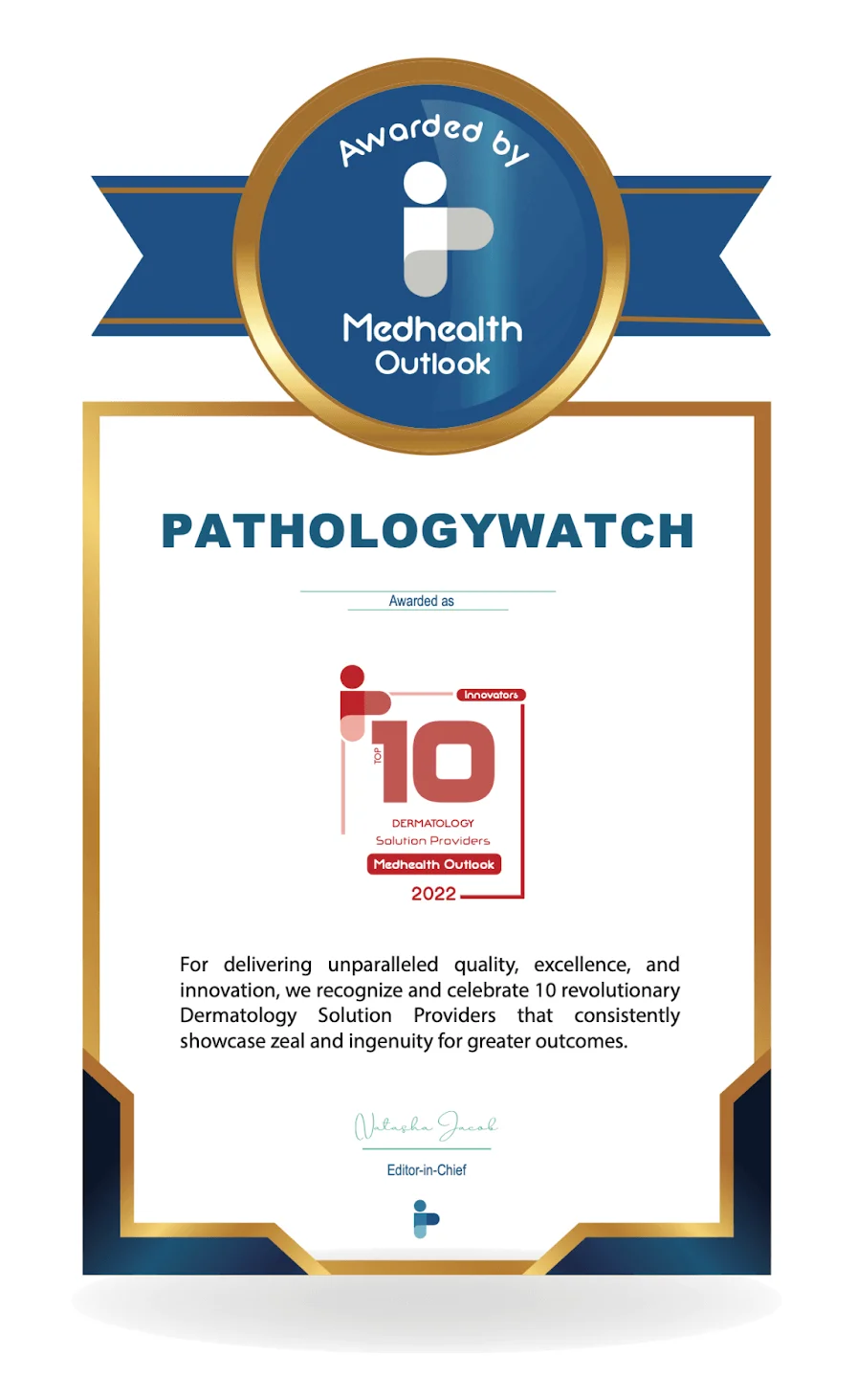May 22, 2025 | Digital Dermatopathology, Digital Pathology, Pathology Business
The 2025 Ogden Surgical Medical Society Conference hosted medical thought leaders from across specialties. What was the burning question on the mind’s of many health professionals? How is artificial intelligence reshaping healthcare—from diagnostics to documentation—and what it means for providers navigating population health and value-based care models?
Greg Osmond, MD, MPH, co-founder of PathologyWatch, and a presenter at this year’s event, positioned the answer as a strategic balance of Pathology, AI, and Population Health.
Here’s a look at the highlights and key takeaways from his session:
Finding the Balance: Pathology, AI, and Population Health
Dr. Osmond opened by framing the most current questions facing clinicians and healthcare organizations today:
- What does an effective balance of pathology, AI, and population health actually look like?
- What can today’s AI really do in clinical practice?
- How can clinics and providers begin to build realistic, AI-enabled workflows?
- And where are we already seeing AI deliver value?
AI in Action: Real-World Applications
Throughout the session, Dr. Osmond highlighted real examples of AI tools currently making waves in healthcare:
- Clinical Documentation: Tools like Nuance DAX Copilot, Microsoft Azure, and Suki.AI help automate note-taking and improve physician efficiency.
- Patient Communication: AI is now generating email responses via EPIC and DAX Copilot, lightening the admin load for busy clinicians.
- Radiology and Diagnostics: Platforms like Viz.AI assist with triage and interpretation in high-volume imaging environments.
- Cardiology: Tools like Cleerly are enabling more precise characterization of coronary artery disease, while Caption Health (GE) supports AI-guided echocardiograms by non-specialists.
- Pathology Diagnostics: Companies like PathAI, PaigeAI, PathologyWatch, and Proscia are transforming the pathology workflow.
- Genomics: Precision medicine platforms such as Tempus are bridging AI with genetic insights to personalize treatment.
Key Insights from Dr. Osmond’s Talk
1. Clinical Context Still Matters
One of the most practical takeaways? Always tell your pathologist what you think you’re sampling—even if you’re unsure. That clinical context shapes how the specimen is interpreted.
“It doesn’t matter if you’re right or wrong—it gives us context to help,” Dr. Osmond said.
For example, distinguishing between lichenoid keratosis and lichenoid interface dermatitis is largely a result of clinical context.
2. Frontline Providers Must Lead the AI Transition
As AI adoption accelerates, Dr. Osmond stressed the importance of input from practicing clinicians. Providers are best positioned to identify workflow friction, operational inefficiencies, and areas where automation makes a real difference.
“AI doesn’t need to be flashy—it needs to solve the right problem and fit into a feasible business model,” he noted.
In short: Those closest to the clinical work need to shape the tools, not just use them.
3. Population Health Needs Real-Time, Actionable Data
From wearable devices to remote patient monitoring, the potential for AI in population health is huge. But to make it work, organizations must link comprehensive clinical data with real-time inputs.
Dr. Osmond challenged the audience to think critically about incentives in value-based care, asking:
- What is the most actionable data?
- What operational model can turn that data into better outcomes?
- How do we build systems that are financially and logistically feasible?
AI in Healthcare: A Moral and Strategic Imperative
The talk ended with a provocative question: What is our obligation when AI or agentic workflows are objectively better—and already available?
The healthcare AI revolution isn’t on the horizon. It’s here. And according to Dr. Osmond, it’s up to providers and healthcare leaders to guide its ethical, effective, and scalable implementation.
“Physicians and healthcare organizations hold the key data. We also hold the responsibility to use it wisely.”
Final Thoughts
As the healthcare industry continues its shift toward proactive, data-driven, value-based models, the integration of AI into healthcare, especially through the lens of population health, isn’t just inevitable—it’s essential.
Dr. Osmond’s insights remind us that while the tools are evolving fast, the mission remains the same: provide high-quality care, reduce friction, and improve outcomes for the communities we serve.
Oct 21, 2024 | Dermatology Practice, Digital Pathology
Dermatology is an 8.9 billion dollar industry and is only continuing to grow, with more dermatology practices seemingly popping up each day. However, managing your own practice and providing up-to-date, exceptional care is time-consuming.
We’ve created a list of 11 tips requiring minimal time investment that you can use to differentiate yourself from the competition and create a thriving dermatology practice.
Tip 1: Enhance Your Online Presence
According to a Brightlocal survey, 98 percent of consumers used the internet to find information about local businesses. With so much traffic, you need to make your business stick out online so potential patients find your practice first. One way to do this is to create a professional, user-friendly website. A poorly designed website will cause potential patients to distrust your brand and take their business elsewhere.
Having a great website is important, but only if people are actually motivated to pay a visit. Invest in SEO (search engine optimization), the practice of making your website and business easier for search engines like Google to find and understand. Search engines won’t recommend your website or business if they don’t understand what you are or what you’re offering.
And don’t forget social media. Post regularly on popular social media platforms like Facebook and Instagram. This will get you in front of an audience that may not be actively seeking your services. Through social media, you’ll grow an audience of people interested in what you’re doing and willing to recommend you to friends and family. There are also great paid advertising opportunities through social media you’ll want to explore.
Tip 2: Optimize Your Google Business Profile
Word of mouth, signage, and other methods to let the world know about your business are still important, but 97 percent of people primarily learn about local businesses online. Your most important asset might just be your Google Business Profile. Google has the lion’s share (over 90 percent) of the search market and should be your main focus.
Be sure to fill out your profile completely. Add accurate business hours, holidays, contact information, and links. Don’t skimp on the images, either—listings with photos are twice as likely to appear reputable.
Reply to all your reviews, good or bad. This shows Google that you’re actively engaging with your patients, and it shows your patients that you value their feedback. Once you have your Google Business Profile completed and are actively managing it, you can branch out to other places where you can list your practice, like Yelp or Bing.
Tip 3: Invest in High-Quality Content Marketing
Content such as blogs, articles, videos, and infographics will help you establish yourself as an expert in all things dermatology. Content marketing is great because an initial investment can pay dividends. An article can be turned into a post for social media, an infographic, or a PR opportunity. Over time, these articles can bring thousands of visitors to your website each month.
Many local businesses don’t see the value in creating blog posts or articles since the customers they serve are strictly local. Visitors to a blog might be from all over the county and can’t become customers, but Google looks at link authority as a ranking factor for your local business. Visits and links to your website increase that authority. The more reputable your website, the more local eyes will be on your listing.
Marketing aside, having a library of resources can be a great benefit to your patients. You can use your articles to help patients understand their conditions and how to treat them. Write an article once (with periodic updates as needed) and reap the benefits for years to come.
Tip 4: Leverage Email Marketing
Email marketing is a great way to engage patients and keep them up to date about your practice. You’ll likely get their email address when they fill out new patient paperwork. Just make sure you include a disclaimer or an opt-out if you plan to send them marketing materials.
Consider sending a regular newsletter with updates, promotions, or educational content. A dermatologist might send a reminder to use sunscreen as summer approaches or let patients know of any patient referral programs they have running.
Tip 5: Offer Teledermatology Services
Whether it’s a work schedule, time constraint, or merely convenience, sometimes, people don’t want to go to the doctor in person. This is where offering teledermatology services can be beneficial. You’re also able to expand your patient pool with people who live too far to drive.
The tricky part of teledermatology and any telehealth service is providing a good experience for the patient. This requires a secure and user-friendly telehealth platform that works well for both doctors and patients. Even with a great platform, navigating electronics and internet connections can make it tricky to have a really good experience.
Tip 6: Foster Strong Patient Relationships
No one wants to feel like just another patient the doctor has to check off the list for the day. On busy days especially, it can be a real challenge to connect with your patients and work on developing those relationships. The good news is that the burden of building that relationship doesn’t have to rest solely on your shoulders as the provider. Use your team and make sure that each patient is having positive and friendly interactions with the members of your team.
Having competent staff at your practice is an essential part of success. Skilled medical staff and office personnel not only make your life easier, but they also make the patient experience better. Every dollar spent on staff training and development is a dollar well spent.
Investing in training and development also makes the staff feel more comfortable and confident when they encounter difficult situations. Helping your staff develop new knowledge and skills will also help them feel more fulfilled at work, generating a positive culture at your practice.
In addition to having meaningful patient interactions at the office, consider sending out thoughtful communications to your patients post-visit. Many offices send out requests for ratings, but how many send a text to check in with a patient with a challenging problem or complicated surgery, for example? Going the extra mile can help you become the only dermatologist they’ll trust with their health.
Tip 7: Network with Local Healthcare Providers
Building an online profile is important when it comes to building and expanding your practice, but many patients rely on referrals from their doctor when they need specialty care. The best way to see referrals from other doctors increase is to network with local healthcare providers. This can be done by calling directly and introducing yourself if you’re a relatively new practice.
Another great option is attending and participating in local health fairs and community events where you can meet a wide variety of other healthcare professionals as well as community members when you may need your services or know someone who does. When you start getting referrals from other doctors, make sure you communicate well with them, return results quickly, and make it a pleasure to work with you.
Tip 8: Utilize Patient Testimonials and Case Studies
Like with most businesses, prospective customers will rely on reviews and testimonials to gauge whether or not they want to do business somewhere. Leverage your positive reviews and testimonials to attract other patients. Display them on your website and social media as social proof of your expertise.
Encourage satisfied patients to leave positive reviews online, especially on your Google business profile. It can be slow to get started, but once you get in the habit, you’ll start to see a lot more patients leaving reviews. Remember to only ask patients for a review when they’ve had a positive experience.
There are lots of software solutions that can help you gather feedback and positive reviews.
Tip 9: Implement a Loyalty Program
A loyalty program is more common for practices that focus on elective healthcare, but it can be successfully implemented in almost any kind of practice. The easiest way to start would be to offer a patient referral gift or bonus of some sort. This incentivizes current patients to share your practice with friends and family. If that friend or family member does become a patient, the referrer gets a gift card or something similar.
Share your referral program on your website and social media and mention it in person when patients come to your clinic. If you change up your gift or award fairly frequently, you’ll be able to more easily determine what kind of reward incentivizes your patients the most and if adding that cost onto the acquisition cost of new patients is worth it for your practice.
Tip 10: Stay Updated with Industry Trends
Healthcare is an ever-evolving industry, dermatology especially. Invest some of your time and energy in attending dermatology conferences and workshops. Become familiar with the latest technology and business practices while networking with others. Make sure you offer the latest treatments with the most impactful technologies where possible.
Tip 11: Ask Them!
At PathologyWatch, we want practices to not just like us but also love us as a partner. Our team regularly performs check-ins with dermatologists and staff to provide honest and open feedback on how we can improve their experience. This leads to many helpful improvements as we strive to offer a unique, exceptional service. Similarly, dermatologists can ask their patients to perform simple client satisfaction surveys, using a few pointed questions that patients can honestly answer without feeling critical.
Even if you choose just one tip to implement, the emphasis on continuous improvement will inspire you and your staff and provide opportunities for great patient experiences, which is one of the main reasons we chose dermatology as a specialty.
If you’re looking for a partner that is also interested in continuous improvement, consider partnering with PathologyWatch for all your digital dermatopathology needs.
Apr 20, 2023 | Digital Pathology, Pathology Business
There is no time like the present to be part of the digital pathology field.
According to a 2022 report published by Facts and Factors Research, the global digital pathology market is expected to grow at a 13.8 percent CAGR increase in the next five years. In a recent Forbes article, Dan Lambert, CEO of PathologyWatch, spotlights several different market factors that are synergistically signaling exciting growth opportunities ahead.
Increased Demand for Remote Work
When the COVID-19 pandemic hit in 2020, many companies saw increased demand for the ability to work remotely. With a national emergency declared in the United States, the Centers for Medicare and Medicaid Services (CMS) waived some requirements for remote pathology sites. The ensuing three years have shown the benefits of digital pathology, especially as the demand for remote work remains high.
Lambert also sees digital pathology as a way to connect people in underserved areas with the latest technological advances in healthcare, which otherwise would not be accessible to them. “I predict that remote digital pathology will eventually help leapfrog the latest technology forward by connecting individual offices with dermpath experts and algorithms throughout the world,” Lambert writes.
New CPT Codes
The College of American Pathologists (CAP) worked with the AMA CPT Editorial Board in 2022 to develop a series of 13 new Category III digital pathology digitization procedure codes, which went into effect on January 1, 2023. Before the change, US labs used the same codes to report a diagnostic read, whether they were made under a microscope or using digital pathology.
The new codes will be used to track the extent to which digital pathology is being utilized, with the hope that it will soon result in additional reimbursement amounts, allowing those using the new technology to recoup some of their costs.
“I see this change providing a clear financial incentive for labs to invest in digital pathology,” Lambert says.
Clinical Correlation
Digital pathology provides a more efficient means of communication between dermatologists and dermatopathologists. Where the old model functioned with biopsy samples placed on glass slides sent off to a lab, digital pathology streamlines the process by scanning the samples into digitized slides. Dermpaths now read the case digitally and can consult in real time with the originating dermatologist.
“Quicker and more efficient diagnosis and communication can position the patient as the real beneficiary of digital pathology advancement,” says Lambert. ”In time, I predict that digital pathology and remote reads by experts will be the industry standard.”
Single-Solution Systems
Until recently, most parts of the digital pathology process were handled separately. In the past, one company might have specialized in building viewers, while one developed diagnostic algorithms, and another specialized in the EMR systems that tracked each patient’s case. But now, vendors like PathologyWatch, with its Dermpath Optimization Tool, have developed systems that cohesively connect each step in the process.
“The fact that a few different vendors have developed start-to-finish systems is a good thing for digital pathology,” Lambert says. “[It] means the industry will continue shifting to support digital solutions.”
To read the full Forbes article, click here.










